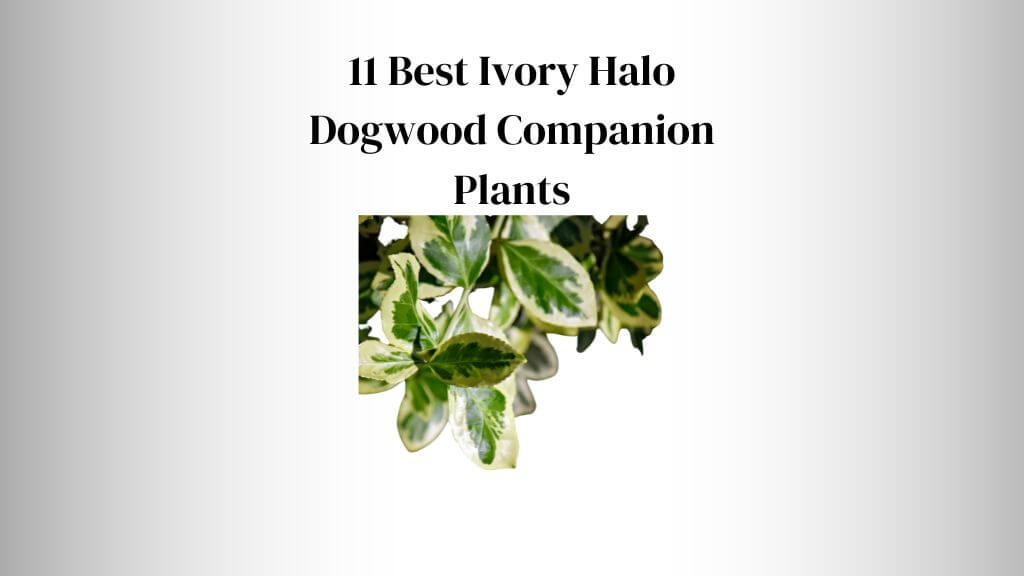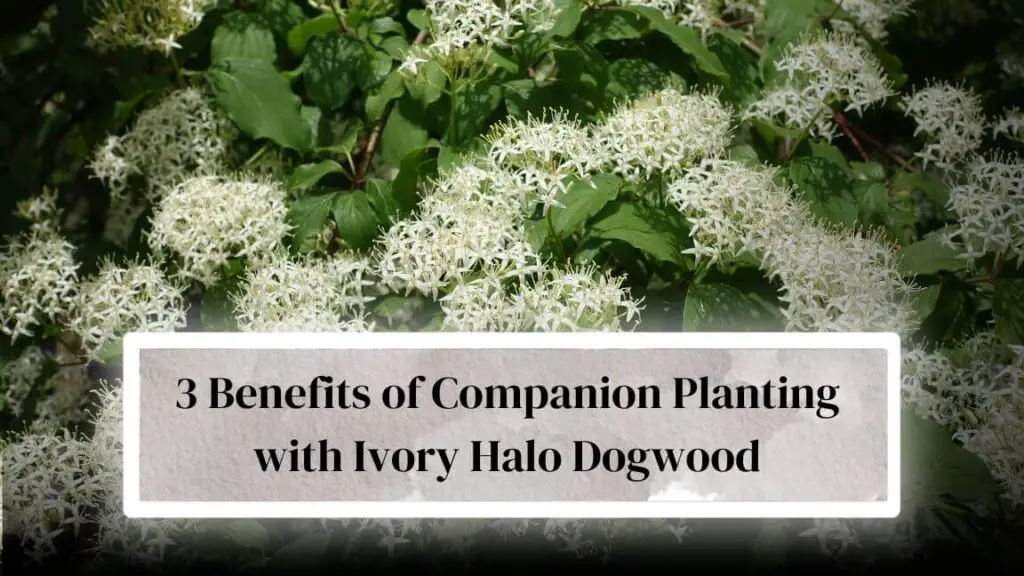
If you want to know what to plant with ivory Halo Dogwood, you’ve read the right article. Hair in this article, I will tell you some of the best Ivory Halo Dogwood Companion Plants according to conditions.
But before I tell you those plants’ names and what you should keep in mind, let’s first find out the benefits of companion planting with Ivory Halo dogwood.
3 Benefits of Companion Planting with Ivory Halo Dogwood

Positive Effects on the Garden
When you plant Ivory Halo Dogwood alongside other plants, there is no competition for nutrients and water due to its shallow root system. Rather, this can positively affect the garden as a whole Its shallow root system can even help stabilize soil erosion on slopes.
Complementing Other Plants
If you have a garden with an aesthetic look, you should plant Ivory Halo Dogwood because its leaf’s unique coloring makes it a great companion to other plants.
I usually pair Ivory Halo Dogwood, particularly with dark-leaved shrubs and perennials, like Black Lace Elderberry & Purple Coneflower. If you don’t know what a normal dogwood specimen looks like, consider reading this first: What Does A Dogwood Tree Look Like
Enhancing Biodiversity
If you want to enhance the biodiversity of your garden and provide a habitat for a range of beneficial insects & birds, consider adding Ivory Halo Dogwood to your garden.
The shrub’s flowers are very good at attracting pollinators like bees & butterflies. Besides that, the dogwood tree berries also provide an excellent food source for birds. If you’re wondering “Can You Eat Dogwood Berries“, read this.
Promoting Insect and Bird Life
According to a study by the Lewis Ginter Botanical Garden, you can promote insect and bird life by companion planting with flowering shrubs like Ivory Halo Dogwood.
Yes, it would help if you used proper pest control, but many beneficial insects, like ladybugs and lacewings, can help you control pests like aphids & spider mites on dogwood trees more effectively.
Improving Soil Health
As I told you earlier, Ivory Halo Dogwood has a shallow root system, making it a great choice for improving soil health.
As this shrub grows, it will shed its leaves, which decompose and add nutrients to the soil. It would help to use this variety to improve soil structure and prevent erosion.
Avoid Planting with Ivory Halo Dogwood
You must always avoid planting any plant that might have to complete root system fora. Stop. As I told you, this particular ivory Halo dogwood shrub comes with a shallow root system, so there are a few specific examples of plants that you must avoid.
3 Types Of Plants That Have Competing Root Systems
- Trees: Any tree with a shallow root system can be complete with an ivory halo dogwood shallow root system. This can lead to the trees needing help to obtain the proper water and nutrients they need. In particular, try to avoid please like oak or maple.
- Shrubs: Shrubs like Japanese barberry & common lilac tend to have similar growth habits or root systems, which can compete with Ivory Halo Dogwood. So, avoid those types.
- Groundcovers: A few certain groundcovers, like English Ivy or Creeping Charlie, come with aggressive root systems. These groundcovers may compete with Ivory Halo Dogwood for nutrients & water. I usually like to choose groundcovers with less invasive root systems like creeping thyme. Alternatively, you can choose creeping phlox as well.
Plants That Require Excessive Watering
Even though Ivory Halo Dogwood prefers moist soil, you should never overwater it or let it flood. Therefore, avoid all types of plants that require excessive watering. Particularly, three types of plants are known to need lots of moisture.
- Ferns: Yes, a few types of ferns need consistently moist soil. It would help if you avoided planting those types altogether, as growing alongside Ivory Halo Dogwood is tough.
- Water-loving Perennials: Plants like hostas & astilbes can only grow if you give moist soil to thrive. Avoid these types, too, as they can also be problematic when planted alongside Ivory Halo Dogwood.
Plants that prefer a different soil pH
At last, you will also need to consider the pH level of your soil when choosing companion plants for Ivory Halo Dogwood.
Since Ivory Halo Dogwood shrub usually likes slightly acidic soil, with a pH range of 5.5 to 6.5, you’ll want to avoid planting other plants that prefer a different soil pH.
- Alkaline-Loving Plants: you should avoid planting any tree that prefers alkaline soil. It would help if you never grew plants like lavender & butterfly weed because these will struggle to grow alongside Ivory Halo Dogwood.
- Acid-Loving Plants: I also avoid plans that like highly acidic soil as there are better choices for companion planting. A few plants that usually like to grow on highly acidic soils are blueberries and rhododendrons.
Best Companion Plants for Ivory Halo Dogwood

Under Full Sun
If you have an Ivory Halo Dogwood that is planted in full sun, here are some companion plants that you can consider:
| Companion Plant | Scientific Name | Height | Spread | Bloom Time |
| Salvia Nemorosa | Salvia Nemorosa | 18-24″ | 18-24″ | Summer |
| Echinacea Purpurea | Echinacea Purpurea | 2-4′ | 1-2′ | Summer to fall |
| Stachys Byzantina | Stachys Byzantina | 12-18″ | 12-18″ | Summer |
| Sedum Spectabile | Sedum Spectabile | 18-24″ | 18-24″ | Late summer to fall |
| Coreopsis Verticillata | Coreopsis Verticillata | 1-3′ | 1-3′ | Summer |
I find Meadow sage, also known as Salvia Nemorosa, a great companion plant for Ivory Halo Dogwood because its purple-blue flowers contrast nicely with the shrubs’ white-edged leaves.
Alternatively, you can grow Purple Coneflower (Echinacea purpurea) alongside ivory halo dogwood. Purple Coneflower (Echinacea purpurea) produces pink to purple flowers that attract pollinators like butterflies & bees.
If you want to complement the texture of the dogwood’s leaves, you can have Lamb’s Ears (Stachys byzantine), known for its soft, furry leaves. If you want to add color to your landscape, consider Autumn Joy Sedum, which produces pink flowers in late summer & fall.
Lastly, Threadleaf Coreopsis (Coreopsis verticillata) is a great companion plant producing beautiful yellow flowers. Threadleaf Coreopsis blooms throughout the summer & early fall, adding a pop of color to your garden.
Under Partial Shade
If your Ivory Halo Dogwood is planted in partial shade, you can consider having any of these:
| Companion Plant | Scientific Name | Height | Spread | Bloom Time |
| Hosta | Hosta spp. | 6-36″ | 12-72″ | Summer |
| Tiarella Cordifolia | Tiarella Cordifolia | 6-12″ | 12-18″ | Spring |
| Geranium Sanguineum | Geranium Sanguineum | 6-12″ | 12-18″ | Late spring to early summer |
| Heuchera | Heuchera spp. | 6-18″ | 12-18″ | Spring to summer |
Many people like Hostas for their shady gardens that pair perfectly with Ivory Halo Dogwood. You will enjoy having Hostas because it is available in varieties of colors & sizes.
Don’t worry much because their lush foliage contrasts beautifully with the variegated leaves of the dogwood. However, if you want to add diversity to your shady landscape, you can consider having Foamflower (Tiarella Cordifolia), which produces delicate white or pink flowers in the spring.
If you are looking for a low-growing perennial, you can go with Bloody Cranesbill (Geranium Sanguineum), which produces pink or purple flowers in late spring to early summer. Also, Coral Bells (Heuchera) are a great companion plant for Ivory Halo Dogwood.
However, if you are looking to add a ground cover that doesn’t compete with your dogwood, go with Dead Nettle (Lamium maculatum), a fast-spreading groundcover that produces pink or white flowers in the spring & summer
Under Full Shade
If your Ivory Halo Dogwood is planted in full shade, which is not good, consider relocating. However, if you’re providing proper lighting, here are some companion plants that you can consider:
| Companion Plant | Scientific Name | Height | Spread | Bloom Time |
| Astilbe | Astilbe spp. | 1-4′ | 1-4′ | Summer |
| Ferns | Various | Various | Various | Various |
| Hakonechloa Macra | Hakonechloa Macra | 12-18″ | 18-24″ | Summer |
| Helleborus | Helleborus spp. | 1-2′ | 1-2′ | Winter to spring |
| Brunnera Macrophylla | Brunnera Macrophylla | 12-15″ | 18-24″ | Spring |
| Digitalis | Digitalis spp. | 3-5′ | 1-2′ | Late spring to summer |
Firstly you need to decide what you have and what you can provide. It is important that you provide some kind of lighting source if your tree is under full shade.
As a companion plant, you can use False Spirea (Astilbe), an excellent choice for a shady garden that produces feathery plumes of pink, white, or red flowers in the summer. I like to pair my indoor ivory halo dogwood with Ferns because they come in a variety of shapes & sizes and add texture to my garden.
Some of the ferns you can choose are Ostrich Fern, Maidenhair Fern, and Christmas Fern. As a ground cover, you can use Japanese Forest Grass (Hakonechloa Macra) that produces bright green leaves which turn golden in the fall. It’s best for shady gardens because it’s a slow-growing grass.
Also Read: Red Twig Dogwood Companion Plants
Conclusion
After reading this article, I hope you will have no problem deciding the right type of companion plant for your Ivory dogwood tree according to specific conditions. If you find this article helpful, then consider sharing it.
Your share will help many people learn about the possible options they can use for companion planting and benefit from it. Check our other helpful guide on dogwood tree care and management shared on this website. See you in the next post, till then, take care and goodbye.
